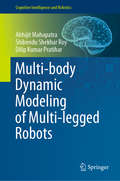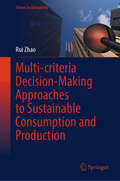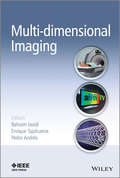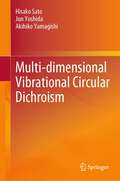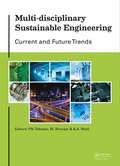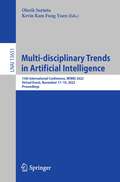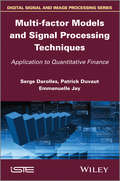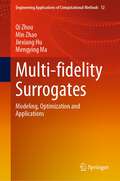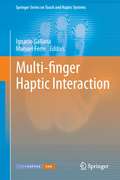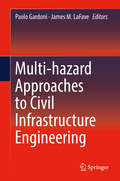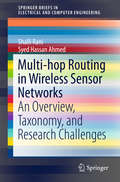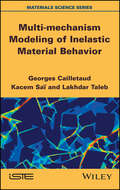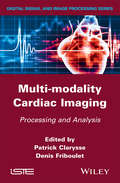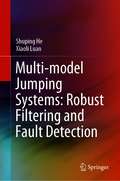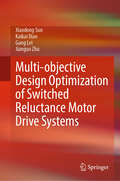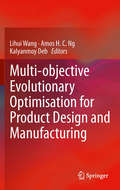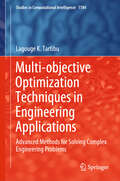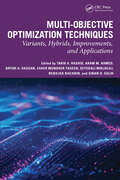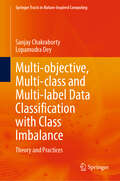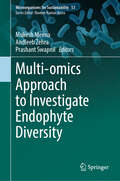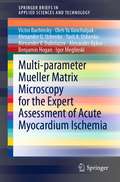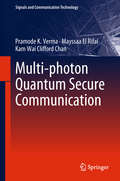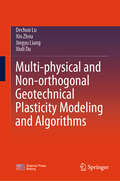- Table View
- List View
Multi-body Dynamic Modeling of Multi-legged Robots (Cognitive Intelligence and Robotics)
by Dilip Kumar Pratihar Abhijit Mahapatra Shibendu Shekhar RoyThis book describes the development of an integrated approach for generating the path and gait of realistic hexapod robotic systems. It discusses in detail locomation with straight-ahead, crab and turning motion capabilities in varying terrains, like sloping surfaces, staircases, and various user-defined rough terrains. It also presents computer simulations and validation using Virtual Prototyping (VP) tools and real-world experiments. The book also explores improving solutions by applying the developed nonlinear, constrained inverse dynamics model of the system formulated as a coupled dynamical problem based on the Newton–Euler (NE) approach and taking into account realistic environmental conditions. The approach is developed on the basis of rigid multi-body modelling and the concept that there is no change in the configuration of the system in the short time span of collisions.
Multi-criteria Decision-Making Approaches to Sustainable Consumption and Production (Urban Sustainability)
by Rui ZhaoThis book applies multi-criteria decision-making (MCDM) approaches to facilitate sustainable consumption and production. Sustainable consumption and production not only focuses on the economic prosperity but also pays great attention to environmental protection and social justice, in order to promote sustainable development. In such context, most ‘material’ can be deemed as ‘hazardous’ at any stage of their lifecycle, i.e., from extraction to final disposal, because of its quantity, concentration, or physical, chemical, or infectious characteristics, may cause, or pose a substantial or potential hazard to human health or the environment. Through the application of system theory, game theory, optimization theory, as well as various computational approaches, this book helps engineers/ policy makers to identify solutions or mitigation strategies to reduce environmental impact associated with consumption and production. It is essential reading for students, researchers, policy makers as well as those with a wider interest in environmental science and sustainable development.
Multi-dimensional Additive Manufacturing
by Soshu Kirihara Kazuhiro NakataIn this book, basic sciences and applied technologies in 3D printing and 2D coating—including 2D surface modulations on 3D printed objects—are described to explore and to image novel multidimensional additive manufacturing. Renowned researchers were selected from universities and national institutes as authors by the editorial board established in the Surface Modification Research and Technology Committee of the Japan Welding Engineering Society. The main readers of this book are expected to be graduate students, professional researchers, and engineers. Here, they can acquire abundant knowledge of digital design concepts and functional evaluations, enabling them practice material selection and process parameter optimization in novel additive manufacturing.
Multi-dimensional Imaging (Wiley - IEEE)
by Bahram Javidi Enrique Tajahuerce Pedro AndresProvides a broad overview of advanced multidimensional imaging systems with contributions from leading researchers in the field Multi-dimensional Imaging takes the reader from the introductory concepts through to the latest applications of these techniques. Split into 3 parts covering 3D image capture, processing, visualization and display, using 1) a Multi-View Approach and 2.) a Holographic Approach, followed by a 3rd part addressing other 3D systems approaches, applications and signal processing for advanced 3D imaging. This book describes recent developments, as well as the prospects and challenges in advances in imaging sciences and engineering such as 3D image sensing, 3D holographic imaging, imaging applications for bio-photonics and 3D image recognition. Advanced imaging systems incorporate knowledge from various fields. It is a complex technology that combines physics, optics, signal processing, and image capture techniques. Provides a broad overview of advanced multidimensional imaging systems with contributions from leading researchers in the field. Integrates the background, introductory material with new advances in 3D imaging and applications. Covers the most recent technologies such as high speed digital holography, compressive sensing, real-time 3D integral imaging, 3D TV, photon counting imaging. To be available as an enhanced ebook with added functionality of colour films showing the effects of advanced 3D applications such as 3D microscopy, 3D biomedical imaging and 3D for security and defense applications. Acts as a single source reference to the rapidly developing field of 3D imaging technology. Provides supplementary material on a companion website including video clips, examples, numerical simulations, and experimental results to show the theoretical concepts. With contributions from leading researchers from across these fields, Multi-dimensional Imaging is a comprehensive reference for the imaging technology research community.
Multi-dimensional Vibrational Circular Dichroism
by Akihiko Yamagishi Hisako Sato Jun YoshidaThis book provides the reader with the latest research on vibrational circular dichroism (VCD) spectroscopy including its useful features and applications to many fields. The book starts from an unresolved question in gel chemistry of how component molecules are organized in the flexible fibrils of gels. VCD spectroscopy was successful in giving a clear answer to this mystery. The book also describes a key aspect of this technique lay in the fact that VCD signals were remarkably enhanced when chiral molecules formed a stereoregular molecular array over a few hundred nanometers. VCD spectroscopy was also applied to other topics involving chiral molecules such as the chiral discrimination mechanism in heterogeneous asymmetric catalysis and the build-up of supramolecular chirality in molecular crystals. Furthermore, the book covers the recent instrument developments leading to multi-dimensional VCD measurements with the coordinates of wavenumber, space and time. This progress has opened up new biological and medical applications such as the heterogenous distributions of protein domains in insect wings and the quality control of chiral drugs. The last part of the book presents the possibility of medical diagnosis of Alzheimer’s disease through multi-dimensional VCD analyses. This book appeals not only to researchers and students who study spectroscopy but also to ones in catalysis, biology and medicine as users of the VCD methods.
Multi-disciplinary Sustainable Engineering: Proceedings of the 5th Nirma University International Conference on Engineering, Ahmedabad, India, November 26-28, 2015
by M. Bhavsar B. A. Modi P. N. TekwaniThe Nirma University International Conference on Engineering NUiCONE is a flagship event of the Institute of Technology, Nirma University, Ahmedabad. NUiCONE-2015 is focussed on events/themes in the current trends in Engineering and its research issues. Practicing engineers, technologists and technopreneurs from the industry&nbs
Multi-disciplinary Trends in Artificial Intelligence: 15th International Conference, MIWAI 2022, Virtual Event, November 17–19, 2022, Proceedings (Lecture Notes in Computer Science #13651)
by Olarik Surinta Kevin Kam Fung YuenThis book constitutes the refereed proceedings of the 15th International Conference on Multi-disciplinary Trends in Artificial Intelligence, MIWAI 2022, held online on November 17–19, 2022.The 14 full papers and 5 short papers presented were carefully reviewed and selected from 42 submissions.
Multi-factor Models and Signal Processing Techniques: Application to Quantitative Finance (Wiley-iste Ser.)
by Serges Darolles Emmanuelle Jay Patrick DuvautWith recent outbreaks of multiple large-scale financial crises, amplified by interconnected risk sources, a new paradigm of fund management has emerged. This new paradigm leverages “embedded” quantitative processes and methods to provide more transparent, adaptive, reliable and easily implemented “risk assessment-based” practices. This book surveys the most widely used factor models employed within the field of financial asset pricing. Through the concrete application of evaluating risks in the hedge fund industry, the authors demonstrate that signal processing techniques are an interesting alternative to the selection of factors (both fundamentals and statistical factors) and can provide more efficient estimation procedures, based on lq regularized Kalman filtering for instance. With numerous illustrative examples from stock markets, this book meets the needs of both finance practitioners and graduate students in science, econometrics and finance. Contents Foreword, Rama Cont. 1. Factor Models and General Definition. 2. Factor Selection. 3. Least Squares Estimation (LSE) and Kalman Filtering (KF) for Factor Modeling: A Geometrical Perspective. 4. A Regularized Kalman Filter (rgKF) for Spiky Data. Appendix: Some Probability Densities. About the Authors Serge Darolles is Professor of Finance at Paris-Dauphine University, Vice-President of QuantValley, co-founder of QAMLab SAS, and member of the Quantitative Management Initiative (QMI) scientific committee. His research interests include financial econometrics, liquidity and hedge fund analysis. He has written numerous articles, which have been published in academic journals. Patrick Duvaut is currently the Research Director of Telecom ParisTech, France. He is co-founder of QAMLab SAS, and member of the Quantitative Management Initiative (QMI) scientific committee. His fields of expertise encompass statistical signal processing, digital communications, embedded systems and QUANT finance. Emmanuelle Jay is co-founder and President of QAMLab SAS. She has worked at Aequam Capital as co-head of R&D since April 2011 and is member of the Quantitative Management Initiative (QMI) scientific committee. Her research interests include SP for finance, quantitative and statistical finance, and hedge fund analysis.
Multi-fidelity Surrogates: Modeling, Optimization and Applications (Engineering Applications of Computational Methods #12)
by Qi Zhou Min Zhao Jiexiang Hu Mengying MaThis book investigates two types of static multi-fidelity surrogates modeling approaches, sequential multi-fidelity surrogates modeling approaches, the multi-fidelity surrogates-assisted efficient global optimization, reliability analysis, robust design optimization, and evolutionary optimization. Multi-fidelity surrogates have attracted a significant amount of attention in simulation-based design and optimization in recent years. Some real-life engineering design problems, such as prediction of angular distortion in the laser welding, optimization design of micro-aerial vehicle fuselage, and optimization design of metamaterial vibration isolator, are also provided to illustrate the ability and merits of multi-fidelity surrogates in support of engineering design. Specifically, lots of illustrative examples are adopted throughout the book to help explain the approaches in a more “hands-on” manner. This book is a useful reference for postgraduates and researchers of mechanical engineering, as well as engineers of enterprises in related fields.
Multi-finger Haptic Interaction
by Manuel Ferre Ignacio GalianaMulti-finger Haptic Interaction presents a panorama of technologies and methods for multi-finger haptic interaction, together with an analysis of the benefits and implications of adding multiple-fingers to haptic applications. Research topics covered include: design and control of advanced haptic devices;multi-contact point simulation algorithms;interaction techniques and implications in human perception when interacting with multiple fingers.These multi-disciplinary results are integrated into applications such as medical simulators for training manual skills, simulators for virtual prototyping and precise manipulations in remote environments. Multi-finger Haptic Interaction presents the current and potential applications that can be developed with these systems, and details the systems' complexity. The research is focused on enhancing haptic interaction by providing multiple contact points to the user. This state-of-the-art volume is oriented towards researchers who are involved in haptic device design, rendering methods and perception studies, as well as readers from different disciplines who are interested in applying multi-finger haptic technologies and methods to their field of interest.
Multi-hazard Approaches to Civil Infrastructure Engineering
by Paolo Gardoni James M. LafaveThis collection focuses on the development of novel approaches to address one of the most pressing challenges of civil engineering, namely the mitigation of natural hazards. Numerous engineering books to date have focused on, and illustrate considerable progress toward, mitigation of individual hazards (earthquakes, wind, and so forth. ). The current volume addresses concerns related to overall safety, sustainability and resilience of the built environment when subject to multiple hazards: natural disaster events that are concurrent and either correlated (e. g. , wind and surge); uncorrelated (e. g. , earthquake and flood); cascading (e. g. , fire following earthquake); or uncorrelated and occurring at different times (e. g. , wind and earthquake). The authors examine a range of specific topics including methodologies for vulnerability assessment of structures, new techniques to reduce the system demands through control systems; instrumentation, monitoring and condition assessment of structures and foundations; new techniques for repairing structures that have suffered damage during past events, or for structures that have been found in need of strengthening; development of new design provisions that consider multiple hazards, as well as questions from law and the humanities relevant to the management of natural and human-made hazards.
Multi-hop Routing in Wireless Sensor Networks
by Shalli Rani Syed Hassan AhmedThis brief provides an overview of recent developments in multi-hop routing protocols for Wireless Sensor Networks (WSNs). It introduces the various classifications of routing protocols and lists the pros and cons of each category, going beyond the conceptual overview of routing classifications offered in other books. Recently many researchers have proposed numerous multi-hop routing protocols and thereby created a need for a book that provides its readers with an up-to-date road map of this research paradigm. The authors present some of the most relevant results achieved by applying an algorithmic approach to the research on multi-hop routing protocols. The book covers measurements, experiences and lessons learned from the implementation of multi-hop communication prototypes. Furthermore, it describes future research challenges and as such serves as a useful guide for students and researchers alike.
Multi-mechanism Modeling of Inelastic Material Behavior
by Georges Cailletaud Lakhdar Taleb Kacem SaiThis book focuses on a particular class of models (namely Multi-Mechanism models) and their applications to extensive experimental data base related to different kind of materials. These models (i) are able to describe the main mechanical effects in plasticity, creep, creep/plasticity interaction, ratcheting extra-hardening under non-proportional loading (ii) provide local information (such us local stress/strain fields, damage, ….). A particular attention is paid to the identification process of material parameters. Moreover, finite element implementation of the Multi-Mechanism models is detailed.
Multi-modality Cardiac Imaging
by Patrick Clarysse Denis FribouletThe imaging of moving organs such as the heart, in particular, is a real challenge because of its movement. This book presents current and emerging methods developed for the acquisition of images of moving organs in the five main medical imaging modalities: conventional X-rays, computed tomography (CT), magnetic resonance imaging (MRI), nuclear imaging and ultrasound. The availability of dynamic image sequences allows for the qualitative and quantitative assessment of an organ's dynamics, which is often linked to pathologies.
Multi-model Jumping Systems: Robust Filtering and Fault Detection
by Shuping He Xiaoli LuanThis book focuses on multi-model systems, describing how to apply intelligent technologies to model complex multi-model systems by combining stochastic jumping system, neural network and fuzzy models. It focuses on robust filtering, including finite-time robust filtering, finite-frequency robust filtering and higher order moment robust filtering schemes, as well as fault detection problems for multi-model jump systems, such as observer-based robust fault detection, filtering-based robust fault detection and neural network-based robust fault detection methods. The book also demonstrates the validity and practicability of the theoretical results using simulation and practical examples, like circuit systems, robot systems and power systems. Further, it introduces readers to methods such as finite-time filtering, finite-frequency robust filtering, as well as higher order moment and neural network-based fault detection methods for multi-model jumping systems, allowing them to grasp the modeling, analysis and design of the multi-model systems presented and implement filtering and fault detection analysis for various systems, including circuit, network and mechanical systems.
Multi-objective Design Optimization of Switched Reluctance Motor Drive Systems
by Gang Lei Jianguo Zhu Xiaodong Sun Kaikai DiaoThis book presents the design optimization method for switched reluctance motors (SRMs) and drive systems. It covers an in-depth literature review on the status and potential trend of design optimization techniques for SRMs, including design theory, modeling methods, topologies, control methods, and techniques for optimization efficiency and effects. Readers will discover new design methods based on the specific nonlinear characteristics of SRMs, and multi-objective optimization methods for the design of high-quality switched reluctance drive systems without or with the consideration of uncertainties, i.e., the deterministic and robust approaches. Multi-mode design optimization method regarding SRMs is investigated and some examples are presented. In addition, some essential trends in design optimization development are presented and highlighted as future perspectives. This book benefits students, researchers, engineers, and companies in the field of electrical drive design and manufacturing. The focuses of this book are different from those of the published books. The advanced optimization methods including deterministic optimization, robust optimization, and system-level optimization are not discussed in these books. Besides, new design method based on the nonlinear characteristic and multi-mode optimization combined with specific application will be introduced to the design of high-performance of switched reluctance machines.
Multi-objective Evolutionary Optimisation for Product Design and Manufacturing
by Lihui Wang Kalyanmoy Deb Amos H. NgWith the increasing complexity and dynamism in today's product design and manufacturing, more optimal, robust and practical approaches and systems are needed to support product design and manufacturing activities. Multi-objective Evolutionary Optimisation for Product Design and Manufacturing presents a focused collection of quality chapters on state-of-the-art research efforts in multi-objective evolutionary optimisation, as well as their practical applications to integrated product design and manufacturing. Multi-objective Evolutionary Optimisation for Product Design and Manufacturing consists of two major sections. The first presents a broad-based review of the key areas of research in multi-objective evolutionary optimisation. The second gives in-depth treatments of selected methodologies and systems in intelligent design and integrated manufacturing. Recent developments and innovations in multi-objective evolutionary optimisation make Multi-objective Evolutionary Optimisation for Product Design and Manufacturing a useful text for a broad readership, from academic researchers to practicing engineers.
Multi-objective Management in Freight Logistics: Increasing Capacity, Service Level, Sustainability, and Safety with Optimization Algorithms
by Massimiliano Caramia Paolo Dell’OlmoThe second edition of Multi-Objective Management in Freight Logistics builds upon the first, providing a detailed study of freight transportation systems, with a specific focus on multi-objective modelling. It offers decision-makers methods and tools for implementing multi-objective optimisation models in logistics. The second edition also includes brand-new chapters on green supply chain and hybrid fleet management problems.After presenting the general framework and multi-objective optimization, the book analyses green logistic focusing on two main aspects: green corridors and network design; next, it studies logistic issues in a maritime terminal and route planning in the context of hazardous material transportation. Finally, heterogeneous fleets distribution and coordination models are discussed.The book presents problems providing the mathematics, algorithms, implementations, and the related experiments for each problem. It offers a valuable resource for postgraduate students and researchers in transportation, logistics and operations, as well as practitioners working in service systems.
Multi-objective Optimization Techniques in Engineering Applications: Advanced Methods for Solving Complex Engineering Problems (Studies in Computational Intelligence #1184)
by Lagouge K. TartibuThis essential book bridges theory and practice, exploring advanced multi-objective optimization methods applied across engineering fields like manufacturing, renewable energy, and thermal management. This book presents a comprehensive, hands-on guide for engineers, researchers, and students seeking to harness the power of optimization in diverse, real-world scenarios. Through expertly crafted chapters, this book illuminates the strengths of state-of-the-art metaheuristic algorithms—such as the Harris hawk optimization, whale optimization, gray wolf optimization, sunflower optimization, imperialistic competitive optimization, jaya optimization, thermal exchange optimization, grasshopper optimization, and cuckoo search optimization. These algorithms tackle complex, high-dimensional challenges, giving readers invaluable tools to boost performance and efficiency. Case studies breathe life into these methods, showcasing their adaptability in systems with multiple conflicting objectives. Readers will find practical MATLAB and GAMS models, enabling immediate experimentation and application. In an era where efficiency and sustainability are paramount, this book equips engineers to solve today’s toughest optimization problems, making it an indispensable resource for those committed to innovation. Whether focused on energy systems, structural design, or computational mechanics, this book serves as a trusted guide to achieving breakthrough solutions across multiple disciplines.
Multi-objective Optimization Techniques: Variants, Hybrids, Improvements, and Applications
by Seyedali Mirjalili Zaher Mundher Yaseen Nebojsa Bacanin Tarik A. Rashid Aram M. Ahmed Bryar A. Hassan Sinan Q. SalihThe book establishes how to design, develop, and test different hybrids of multi-objective optimization algorithms. It presents several application areas of multi-objective optimization algorithms. Presents a thorough analysis of equations, mathematical models, and mechanisms of multi-objective optimization algorithms. Explores different alternatives of multi-objective optimization algorithms to solve binary, multi-objective, noisy, dynamic, and combinatorial optimization problems. Illustrates how to design, develop, and test different hybrids of multi-objective optimization algorithms. Discusses multi-objective optimization techniques for cloud, fog, and edge computing. Highlights applications of multi-objective optimization in diverse sectors such as engineering, e-healthcare, and scheduling. The text is primarily written for senior undergraduates, graduate students, and academic researchers in the fields of electrical engineering, electronics, communications engineering, computer science and engineering, and mathematics.
Multi-objective, Multi-class and Multi-label Data Classification with Class Imbalance: Theory and Practices (Springer Tracts in Nature-Inspired Computing)
by Sanjay Chakraborty Lopamudra DeyThis book explores intricate world of data classification with 'Multi-Objective, Multi-Class, and Multi-Label Data Classification.' This book studies sophisticated methods and strategies for working with complicated data sets, tackling the difficulties of various classes, many objectives, and complicated labelling tasks. This resource fosters a deeper grasp of multi-dimensional data analysis in today's data-driven world by providing readers with the skills and insights needed to navigate the subtleties of modern classification jobs, from algorithmic techniques to practical applications.
Multi-omics Approach to Investigate Endophyte Diversity (Microorganisms for Sustainability #53)
by Mukesh Meena Andleeb Zehra Prashant SwapnilThis book deals with the multi-omics approaches to investigate the diversity of endophytes and their interaction with plants in diversified ecological systems. This book helps to integrate the omics approaches to understand the detailed structure of plant-microbial interactions and the mechanism of plant-microbe responses under various environmental conditions. It discusses different omics technologies including metabolomics, genomics, metagenomics, and volatilomics in plant disease. It also incorporates parts of the ecology and genetics of fungal endophytes, particularly how they identify with the host genome and the synthesis of significant and beneficial products. The proteomic trends of fungal endophytes is scrutinized, offering valuable insights for biotechnological applications. The book further explores the impact of fungal endophytes on nutrient cycling within the rhizosphere microbiome, providing a holistic view of their influence on nutrient dynamics and related microbialcommunities. This book serves as a reference resource for researchers and practitioners working towards advancements in agriculture, environmental science, and biotechnology.
Multi-parameter Mueller Matrix Microscopy for the Expert Assessment of Acute Myocardium Ischemia (SpringerBriefs in Applied Sciences and Technology)
by Igor Meglinski Victor Bachinsky Alexander Bykov Benjamin Hogan Oleh Ya Vanchulyak Alexander G. Ushenko Yurii A. Ushenko Alexander V. DubolazovThis book provides an essential overview of the basic principles of imaging modalities, accompanied by examples of their applications in modern clinical and associated pre-clinical studies. The monograph is based on the original results of investigation of the efficiency use of laser light and Mueller-matrix polarimetry approach for assessment of myocardial tissues towards confirmation the cause of death. A morphological analysis of necrotic changes in the myocardial tissue of patients that died due to heart attack, coronary heart disease and acute coronary insufficiency was carried out and the data and histological sections of the myocardium inspected utilizing Mueller-matrix mapping of tissue samples with polarized light. A unified optical model of polycrystalline structure of the myocardium is proposed, and the principles and regulations of Mueller-matrix description of its polarization manifestations are explored and developed. The book also provides a statistical and scale-selective wavelet analysis of polarization and Mueller-matrix maps. Finally, the key forensic medical criteria for the differential diagnosis of the cause of death due to necrotic and pathological changes in the morphological structure of the myocardium have been established
Multi-photon Quantum Secure Communication (Signals and Communication Technology)
by Pramode K. Verma Mayssaa El Rifai Kam Wai ChanThis book explores alternative ways of accomplishing secure information transfer with incoherent multi-photon pulses in contrast to conventional Quantum Key Distribution techniques. Most of the techniques presented in this book do not need conventional encryption. Furthermore, the book presents a technique whereby any symmetric key can be securely transferred using the polarization channel of an optical fiber for conventional data encryption. The work presented in this book has largely been practically realized, albeit in a laboratory environment, to offer proof of concept rather than building a rugged instrument that can withstand the rigors of a commercial environment.
Multi-physical and Non-orthogonal Geotechnical Plasticity Modeling and Algorithms
by Xiuli Du Dechun Lu Xin Zhou Jingyu LiangThis book primarily introduces innovative multi-physical plastic modeling for geomaterials in unsteady environments and advanced numerical methods for elastoplastic models, topics not systematically covered in other literature. The constitutive models in the form of stress-strain-environment will be interesting to students and researchers in geotechnical engineering and rock and soil mechanics. The book provides a thorough exploration of modeling techniques and algorithmic flowcharts, facilitating a deeper understanding of both theoretical models and numerical methods. It also guides readers in applying these tools to describe the mechanical behavior of geomaterials in various unsteady environments and addresses computational challenges in elastoplastic numerical analysis.
